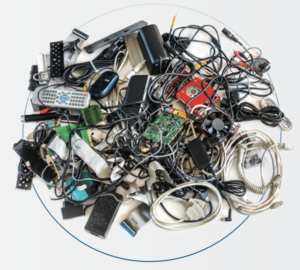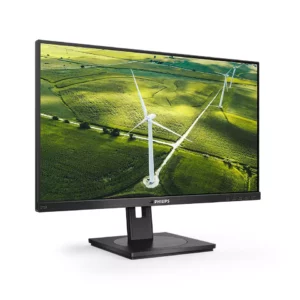Monitoring Sustainability in the IT Sector
An interview with Stefan van Sabben and Artem Khomenko.
In the fast-paced IT sector, sustainability and e-waste are becoming more and more crucial for the development of In the fast-paced IT sector, sustainability and e-waste are becoming more and more crucial for the development of businesses. As a manufacturer, MMD, understands that the company holds a lot of responsibility and has the vision to tackle this issue holistically. We had a chat with Stefan van Sabben, MMD’s Global CSR and Sustainability Senior Manager, and Artem Khomenko, Head of Product Development AOC & MMD, to speak about sustainability, research, and waste reduction.
Sustainability plays an increasingly important role in modern companies. How does Philips monitors/ MMD approach this topic?
Stefan van Sabben: We believe that the whole industry needs to fundamentally rethink product development and business models. The increased concern for sustainability also reflects demands from consumers, who want to invest in products with longer lifespans, are repairable and recyclable, and impact the environment the least amount possible. Most importantly, the driving force for this change should come from the companies and their respective workforces themselves. And that’s how we’re approaching this subject.

Senior manager GlobalCSR & Sustainability
TPV’s intrinsic motivation to play a key role in this change process is reflected in all our employees, from top management positions to the intern. Therefore, we’re taking a holistic approach. We’re improving existing portfolios to be more environmentally friendly, from sourcing sustainable materials used to create our products to using less packaging and less plastic to reduce waste. Moreover, we’re training our product design teams to create more sustainable products from scratch. By working with partners such as Closing the Loop (CTL), PACT, and ForestNation, we’re thinking about the entire product cycle, from the very beginning of the supply chain – the mining of minerals – to what happens to the product after the end of its lifespan, as it turns to e-waste.
Is enough being done for sustainability in global IT/consumer electronics?
Stefan van Sabben: It requires an enormous amount of work and a continuous effort to change the world to be more sustainable, and all players in IT and consumer electronics need to dedicate themselves more to this development.
The fast pace of technology naturally results in new products being developed in the IT/CE sectors much more frequently than any other industry. This both complicates and stimulates the need to produce more sustainable products.
Right now at TPV, we’ve been increasing our use of recycled plastic in our products instead of using newly-made plastics. Our packaging now includes less plastic and more paper. We’re also experimenting with new materials. Further, in order to establish holistic systems, we are now starting at the very base of the product cycle by introducing circular thinking (reduce, reuse, refurbish, repair and recycle) into our design and production processes.
This will generate more comprehensive results, such as reducing the overall energy and material consumption during manufacturing, producing longer lasting or upgradable products, using recycled and recyclable (bio-based) materials and reinventing our business models to add services to match these ambitious goals.

Electronic waste is a pressing problem. As one of the leading monitor manufacturers, how do you tackle this issue?
Stefan van Sabben: Computer monitors contain pretty small circuit-boards and are therefore generally considered hardly worth the effort of recycling. In our pilot project with Closing the Loop (CTL) and TCO Development we aim to support the reduction of reduce monitor waste. This project aims to ensure traceability, shipping, and safe recycling of the collected waste, while a research institute (ÖkoInstitute e. V.) will focus on environmental and social risks. With this project, a certified recycling process will be established, setting new sustainability standards for the monitor industry.
How does sustainability influence MMD’s portfolio and design processes?
Artem Khomenko: It is now common in the CE/IT sector to have a Cradle to Grave (C2G) product lifecycle – all products, once introduced to the market, will ultimately end up as waste. Our goal is to overthrow this one-way lifecycle and transform it to a Cradle to Cradle (C2C) process.
Right now we are introducing circular thinking and sustainable ideas in our entire company strategy, resulting in new products with more sustainable designs, features and packaging.
For instance, by incorporating sustainable ideas into the design processes we created a new bezel design that requires drastically less plastic compared to previous designs.
Beyond this, we focus on aspects that make working more convenient by creating more monitors that feature USB-C technology, which makes many additional cables become obsolete and thus reduces e-waste.
As part of our green goals we are setting up a roadmap to convert all packaging from EPS foam to paper cushion and to further reduce plastic materials in our packaging, such as wires, plastic bags and CD-ROMs.
For B2B monitors, we are switching entirely to brown cardboard boxes with more simple prints, saving valuable resources and paving the way for improved recycling of the used materials.

Which features of Philips monitorshelp users to work efficiently andmore sustainability?
Artem Khomenko: In terms ofsustainability, first and foremost ourproducts have been designed with asustainability perspective before theirproduction. We are also proud to be oneof the first display manufacturers on themarket with products that received thesustainability certification TCO Certified9.0. In fact, with 64 monitors carrying thisdesignation, we have one of the largestportfolios of models on the marketaccredited with TCO Certified 9.0.
The most obvious examples of ourcommitment are our “greenest” monitorsto date, the 24” 242B1G and the 27”272B1G. These models are equipped witha new LED backlight technology. Thanksto this, they can maintain brightness andcolour consistency whilst using significantlyless energy, reducing energy consumption,and prolonging the lifetime of the model.
The 24” model only consumes 8.6 W in Ecomode and just 12.8 W typically with theEnergyStar testing method. With the newcategorisation of Energy Label classes inthe EU starting from 2021, the 242B1G israted class C, which only a small subsetof monitors on the market were able toachieve. Both models are of course fullof the green features that we’re alreadyimplementing in the restof our portfolio.
We use zero plastics and no harmfulchemicals in the packaging of our greenmodels, and we’re increasingly expandingthis “green and sustainable” thinking to ourentire portfolio.
For example, the majority of our businessmodels are made from 85% post-consumerrecycled plastic and the casing of ourmonitors is PVC/BFR free. The packagingmaterial we use is also 100% recyclableand, soon, we will transition to packagingwith only single colour and ink for all B2Bmodels, which will further reduce costs andallow better recycling.
We equip many of our B2B models withPowerSensor and LightSensor features,which use infrared sensors. The formerreduces the brightness when it detects noone is sitting in front of display.
While the LightSensor, in comparison, is afeature that increases the users’ comfort,adapting the brightness of the screenaccording to the ambient light it senses.
Moreover, many monitors in ourportfolio fulfil multiple regulations,including EnergyStar 8.0, EPEAT, TCOCertified Edge and TUV Eye Comfort,and more. Additionally, our monitors aremercury-free and RoHS-compliant. In mostof our business models, we also havea physical power switch, so the monitorwill draw zero power from the mainswhen turned off.
Finally, by integrating many featuresin the monitor itself that are essentialto many businesses, such as a webcam,USB hub, KVM switch etc., we reducefurther e-waste by eliminating theneed for additional dongles, hubs andsuch products.